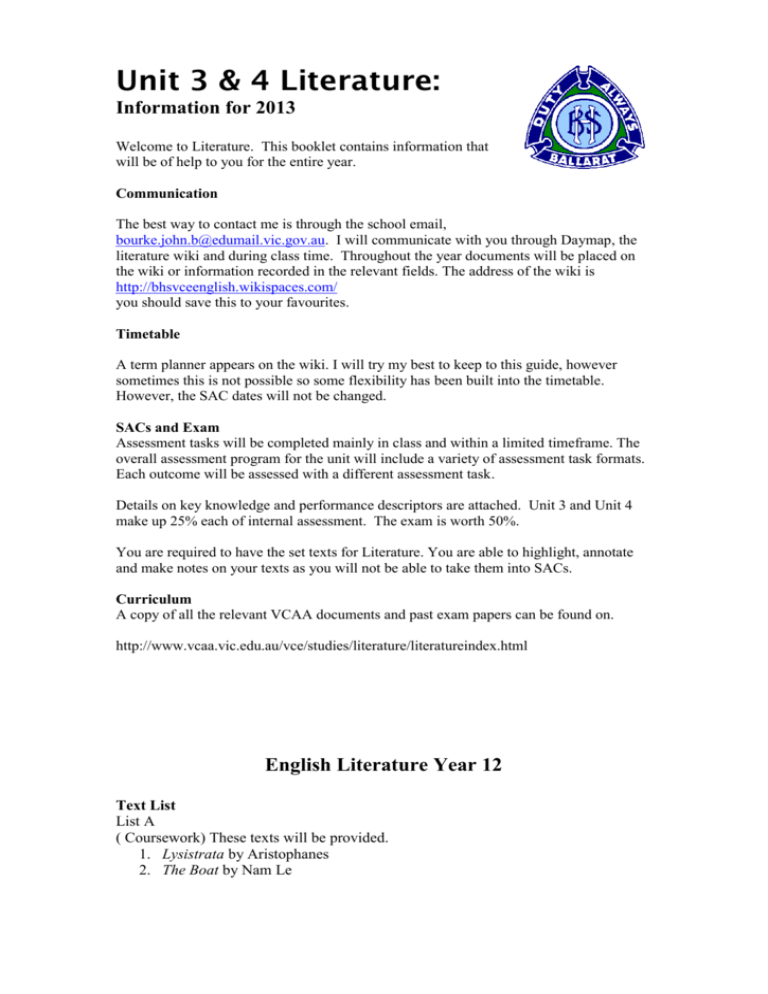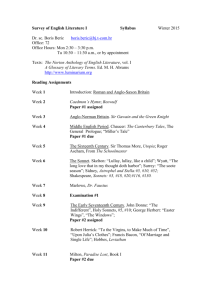1096 - Ballarat High School
advertisement

Unit 3 & 4 Literature: Information for 2013 Welcome to Literature. This booklet contains information that will be of help to you for the entire year. Communication The best way to contact me is through the school email, bourke.john.b@edumail.vic.gov.au. I will communicate with you through Daymap, the literature wiki and during class time. Throughout the year documents will be placed on the wiki or information recorded in the relevant fields. The address of the wiki is http://bhsvceenglish.wikispaces.com/ you should save this to your favourites. Timetable A term planner appears on the wiki. I will try my best to keep to this guide, however sometimes this is not possible so some flexibility has been built into the timetable. However, the SAC dates will not be changed. SACs and Exam Assessment tasks will be completed mainly in class and within a limited timeframe. The overall assessment program for the unit will include a variety of assessment task formats. Each outcome will be assessed with a different assessment task. Details on key knowledge and performance descriptors are attached. Unit 3 and Unit 4 make up 25% each of internal assessment. The exam is worth 50%. You are required to have the set texts for Literature. You are able to highlight, annotate and make notes on your texts as you will not be able to take them into SACs. Curriculum A copy of all the relevant VCAA documents and past exam papers can be found on. http://www.vcaa.vic.edu.au/vce/studies/literature/literatureindex.html English Literature Year 12 Text List List A ( Coursework) These texts will be provided. 1. Lysistrata by Aristophanes 2. The Boat by Nam Le List B (SACs, coursework and examinations) These texts must be purchased. 1. Who’s Afraid of Virginia Woolf? by Edward Albee (N.B The first SAC for the year will be a comparison between the written text and a film version of ‘Who’s Afraid of Virginia Woolf? starring Richard Burton and Elizabeth Taylor. If you are able to watch this version, it would be helpful.) 2. The French Lieutenant’s Woman by John Fowles (There is a 1980 film version starring Meryl Streep available. It is interesting, but not very helpful to your study as it is so different to the book. If you think you can watch the film and not read the book, forget it!) 3. Collected Stories by Peter Carey. These are the stories you must read. ‘Do You Love Me?’, ‘Life & Death in the South Side Pavilion’, ‘Room No. 5 (Escribo)’, ‘Peeling’, ‘A Windmill in the West’, ‘Concerning the Greek Tyrant’, ‘Conversations with Unicorns’, ‘American Dreams’, ‘The Fat Man in History’, ‘A Schoolboy Prank’, ‘The Chance’, ‘He Found Her in Late summer’ 4. Selected Poems, Adrienne Rich. These are the poems you must read. Storm Warnings, Aunt Jennifer’s Tigers, Ideal Landscape, Necessities of Life, The Trees Jerusalem, A Valediction Forbidding Mourning, Diving into the Wreck, The Fact of a Doorframe, Twenty-One Love Poems, V – IX, North American Time, Dreamwood, Harpers Ferry ,What Kind of Times Are These, Rusted Legacy SACs and Texts Unit 3 Area of Study 1: Transformations and Adaptations (40 marks) Who’s Afraid of Virginia Woolf. Area of Study 2: Views and Values (40 marks) Rich Area of Study 3 Considering Alternative Viewpoints (20 marks) The French Lieutenant’s Woman Unit 4 Area of Study 1: Creative Response and Commentary (60 marks) Carey Area of Study 2: Close Analysis (40 marks) List B texts: The French Lieutenant’s Woman, Rich poetry, Collected Stories- Peter Carey, Who’s Afraid of Virginia Woolf? Assessment Weighting Examinations: 50% of total SACs: 50% of total, comprising: Unit 3: 25% Unit 4: 25% English Literature Year 12 Outcome Details UNIT 3 Area of Study 1: TRANSFORMATIONS and ADAPTATIONS Outcome One The focus here is on how the form of a text is significant in the making of meaning. On completion of this unit the student should be able to analyse how meanings change when the form changes Key Knowledge includes: The way forms of text are significant in creating meaning Conventions used in a particular form of text – for example, the use of setting, plot and narrative voice in novels, the use of images and sound in film Differences in meaning conveyed when a text is adapted or transformed Key Skills include the ability to: Analyse the construction of texts in terms of such elements as characterisation, tone, style, structure and point of view Identify typical features of forms of texts and genres, and evaluate their significance in terms of the making of meaning Identify and comment on the similarities and differences between the original and the adapted or transformed text Area of Study 2 VIEWS, VALUES and CONTEXTS Outcome Two The focus here is on a consideration of the views and values in texts and the ways in which these are expressed to create particular perspectives upon the world. Students consider the issues, ideas and contexts writers choose to explore and the way these are represented in texts. On completion of this unit the student should be able to analyse, interpret and evaluate the views and values of a text in terms of the ideas, social conventions and beliefs that the text appears to endorse, challenge of leave unquestioned. Key Knowledge includes: How contexts (cultural, social, historical or ideological) may influence the construction of the text The ways in which the text may reflect, reveal, or provide a critique of aspects of human behaviour, social convention or society The ways contemporary beliefs and values influence the student’s interpretations How the writer’s construction of the text can influence interpretations, for example the choice of characterisation, social and historical setting, structure, point of view, imagery and style. Key skills include the ability to: Identify and discuss the views and values represented in the text Analyse how views and values are suggested by what the text endorses, challenges and leaves unquestioned Compare different interpretations of the text Justify an interpretation of views and values of a text through close attention to textual detail. Area of Study 3 CONSIDERING ALTERNATIVE VIEWPOINTS Outcome Three The focus here is on how various interpretations and judgments about a text can contribute to the students’ interpretations. Students engage with the viewpoints of others, for example, in a review, critical essay and commentary. They explore the underlying values and assumptions of these viewpoints. They consider what is questioned by the text, for example the text’s representation of gender, socioeconomic status, place and culture. On completion of this unit the student should be able to evaluate views of a text and make comparisons with their own interpretation. Key knowledge includes: The viewpoints and assumptions of a review, critical essay or commentary How various viewpoints about a text can be developed How to construct a response that articulates and justifies an independent interpretation. Key skills include the ability to: Identify the viewpoints or theoretical perspectives expressed in a review, critical essay or commentary Demonstrate an understanding of the underlying values and assumptions of the review, critical essay or commentary Evaluate another interpretation Construct an interpretation providing supporting evidence from the text. Unit 4 Area of Study 1 CREATIVE RESPONSES TO TEXTS Outcome One The focus here is on the imaginative techniques used for creating and re-creating a literary work. In composing their own responses, students show both how writers develop images of people and places, and an understanding of language, voice, form and structure. In their adaptation of the tone and the style of the original text, students show an understanding of the concerns and attitudes of the text. Students also reflect critically upon aspects of the text on which their own writing is based, and discuss the purpose and context of their response. On completion of this unit the student should be able to respond imaginatively to a text, and comment on the connections between the text and the response. Key knowledge includes: The point of view, context and form of the original text Features of the original text such as characterisation, setting, narrative structure, tone and style of the language and their effects Techniques used to create, recreate or adapt a text Key skills include the ability to: Identify and recreate imaginatively what is particular about the construction, context, point of view and form of individual texts choose stylistically appropriate features such as characterisation, setting, narrative, tone and style demonstrate insight into abstract and complex ideas reflect critically on what was learned about the original text in the process of producing a creative response. Area of Study 2 CLOSE ANALYSIS Outcome Two The focus here is on detailed scrutiny of the style, concerns and construction of a text. Students attend closely to textual details to examine the ways specific features and/or moments in the text contribute to their overall interpretations. Students may wish to consider features of the text such as structure, context, genre, imagery, rhythm, irony, voice, setting, stage directions, dialogue, characterisation and mood. On completion of this unit the student should be able to analyse critically features of a text, relating them to an interpretation of the text as a whole. Key knowledge includes: The effects and nuances of language in the text The significance of key passages in interpreting the text as a whole Connections between features of a text in developing an interpretation The conventions appropriate to presenting an interpretation, such as detailed reference to the text, logical sequencing of ideas, persuasive language and development of argument. Key skills include the ability to: Comment on how certain moments in a text can reveal or reflect developments in the text Analyse the features of a text and make appropriate connections between them End-of-year examination Description The task is designed to assess students ability to write sustained interpretations of two different kinds of texts. Students will produce two pieces of writing in response to questions that require critical analysis and interpretation of two texts studied. The examination will be set by a panel appointed by the Victorian Curriculum and Assessment Authority. Conditions The examination will be completed under the following conditions: • Duration: two hours. • Date: end-of-year, on a date to be published annually by the Victorian Curriculum and Assessment Authority. • Victorian Curriculum and Assessment Authority examination rules will apply. Details of these rules are published annually in the VCE and VCAL Administrative Handbook. • The examination will be marked by a panel appointed by the Victorian Curriculum and Assessment Authority. Contribution to final assessment The examination will contribute 50 per cent to the study score.








